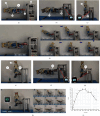Design and Control of an Upper Limb Bionic Exoskeleton Rehabilitation Device Based on Tensegrity Structure
- PMID: 39239384
- PMCID: PMC11377110
- DOI: 10.1155/2024/5905225
Design and Control of an Upper Limb Bionic Exoskeleton Rehabilitation Device Based on Tensegrity Structure
Abstract
Upper limb exoskeleton rehabilitation devices can improve the quality of rehabilitation and relieve the pressure of rehabilitation medical treatment, which is a research hotspot in the field of medical robots. Aiming at the problems such as large volume, high cost, low comfort, and difficulty in promotion of traditional exoskeleton rehabilitation devices, and considering the lightweight, discontinuous, high flexibility, and high biomimetic characteristics of tensegrity structure, we designed an upper limb bionic exoskeleton rehabilitation device based on tensegrity structure. First, this article uses mapping methods to establish a mapping model for upper limb exoskeletons based on the tensegrity structure and designs the overall structure of upper limb exoskeletons based on the mapping model. Second, a bionic elbow joint device based on gear and rack was designed, and the stability of the bionic elbow joint was proved using the positive definite matrix method. This device can simulate the micro displacement between bones of the human elbow joint, improve the axial matching ability between the upper limbs and the rehabilitation device, and enhance the comfort of rehabilitation. Third, an impedance control scheme based on back propagation (BP) neural network was designed to address the low control accuracy of flexible structures and patient spasms. Finally, we designed the impedance control scheme of the PSO-BP neural network based on a fuzzy rehabilitation state evaluator. The experimental results show that the exoskeleton rehabilitation device has good flexion motion stability and assist ability and has significant advantages in volume and mobility. The control strategy proposed in this paper has high control precision and adaptive ability and has potential application value in the field of medical rehabilitation.
Copyright © 2024 Peng Ni et al.
Conflict of interest statement
The authors declare that they have no conflicts of interest.
Figures






Similar articles
-
Pilot Study of a Powered Exoskeleton for Upper Limb Rehabilitation Based on the Wheelchair.Biomed Res Int. 2019 Dec 17;2019:9627438. doi: 10.1155/2019/9627438. eCollection 2019. Biomed Res Int. 2019. PMID: 31976331 Free PMC article.
-
[Mechanical Design and Research of Wearable Exoskeleton Assisted Robot for Upper Limb Rehabilitation].Zhongguo Yi Liao Qi Xie Za Zhi. 2022 Jan 30;46(1):42-46. doi: 10.3969/j.issn.1671-7104.2022.01.009. Zhongguo Yi Liao Qi Xie Za Zhi. 2022. PMID: 35150106 Chinese.
-
Biomimetic Design and Validation of an Adaptive Cable-Driven Elbow Exoskeleton Inspired by the Shrimp Shell.Biomimetics (Basel). 2025 Apr 28;10(5):271. doi: 10.3390/biomimetics10050271. Biomimetics (Basel). 2025. PMID: 40422101 Free PMC article.
-
Robotic exoskeletons: a perspective for the rehabilitation of arm coordination in stroke patients.Front Hum Neurosci. 2014 Dec 1;8:947. doi: 10.3389/fnhum.2014.00947. eCollection 2014. Front Hum Neurosci. 2014. PMID: 25520638 Free PMC article. Review.
-
Flexible lower limb exoskeleton systems: A review.NeuroRehabilitation. 2022;50(4):367-390. doi: 10.3233/NRE-210300. NeuroRehabilitation. 2022. PMID: 35147568 Review.
Cited by
-
Motion Patterns Under Multiple Constraints and Master-Slave Control of a Serial Modular Biomimetic Robot with 3-DOF Hydraulic Muscle-Driven Continuum Segments.Biomimetics (Basel). 2025 Apr 29;10(5):278. doi: 10.3390/biomimetics10050278. Biomimetics (Basel). 2025. PMID: 40422108 Free PMC article.
References
-
- Manna S. K., Bhaumik S. A bioinspired 10 DOF wearable powered arm exoskeleton for rehabilitation. Journal of Robotics . 2013;2013:15. doi: 10.1155/2013/741359.741359 - DOI
-
- Huang J., Tu X., He J. Design and evaluation of the RUPERT wearable upper extremity exoskeleton robot for clinical and in-home therapies. IEEE Transactions on Systems, Man, and Cybernetics: Systems . 2016;46(7):926–935. doi: 10.1109/TSMC.2015.2497205. - DOI
LinkOut - more resources
Full Text Sources

